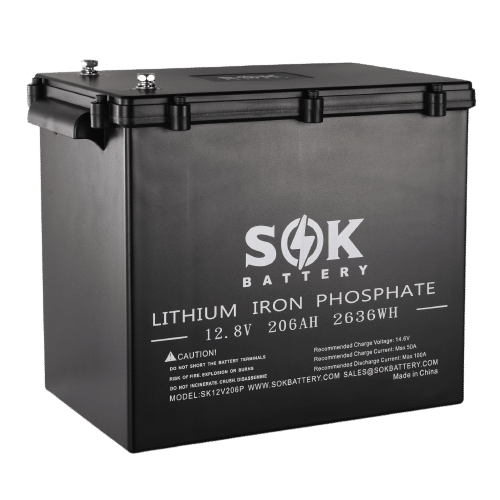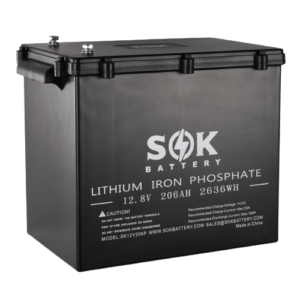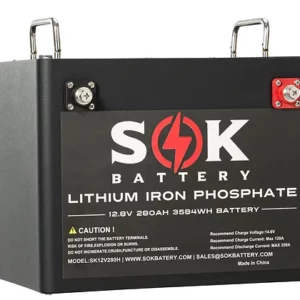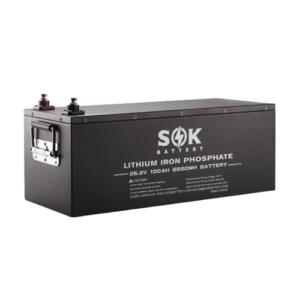Powering Your Off-Grid Adventures: SOK 12V 206Ah IP50 Rated Lithium Battery
Experience reliable and long-lasting power with the SOK 12V 206Ah IP50 Rated Lithium Battery. It’s designed to exceed expectations and deliver unparalleled performance for all your power needs. Whether you’re embracing the freedom of van life, enjoying the comforts of a motorhome or boat, or powering your off-grid cabin, this battery is your dependable energy companion. Don’t settle for less when you can have exceptional value with a SOK Battery!
Capacity and Voltage
The SOK 12V 206Ah IP50 Rated Lithium Batteryy provides ample power capacity with its 206Ah rating, ensuring a reliable energy source for your applications.
Max Discharge and Charge
With a maximum continuous discharge of 100A and maximum charge rate of 50A, this battery is capable of delivering and receiving power efficiently, catering to your power demands.
Detachable Cover and Replaceable BMS and Cells
The battery features a convenient detachable cover, enabling easy access to the internal components for maintenance or replacement. Both of the Battery Management System (BMS) and individual cells are replaceable, ensuring long-term functionality.
Cycle Life Span and Built-In Smart BMS
Expect exceptional durability from the SOK battery, as it offers an impressive 4000-8000 cycle life span. It is equipped with a built-in Smart BMS, providing intelligent monitoring and protection to optimize performance and prolong battery life.
Low Temperature Charging Protection and Grade A Cells
The battery incorporates low-temperature charging protection, ensuring safe and efficient charging even in colder environments. It utilizes Grade A cells, known for their high-quality and reliability, ensuring consistent power output.
User-Serviceable Design and Thick Heat-Sink
Created with user convenience in mind, the SOK battery features a user-serviceable design, allowing for easy maintenance or component replacement. Additionally, its 5mm thick heat-sink aids in heat dissipation, promoting optimal battery performance.
Comprehensive Protection and Auto Balance
Enjoy peace of mind with the SOK battery’s comprehensive protection against overcharging, discharging, and short circuits, safeguarding both the battery and connected devices. The battery cells auto-balance, ensuring consistent performance and longevity.
High and Low Temperature Disconnects
The battery is equipped with high and low temperature disconnects, adding an extra layer of protection in extreme temperature conditions.
Choose the SOK 12V 206Ah Lithium-Iron Phosphate Deep Cycle Battery for reliable power, exceptional durability, and a range of intelligent features. Whether it’s for your RV, van life, off-grid cabin, or other applications, trust the SOK battery to deliver outstanding performance and value!
Safety Advantages of the SOK 12V 206Ah IP50 Rated Lithium Battery: An Excellent Choice for Solar Energy Systems
When it comes to applications where safety is a top concern, manufacturers across industries are turning to Lithium Iron Phosphate (LiFePO4) batteries. LiFePO4 batteries are known for their excellent thermal and chemical stability, which makes them the ideal choice for high-risk applications. The LiFePO4 battery remains cool in higher temperatures and is incombustible in the event of rapid charges, discharges, or short circuit issues. Unlike traditional lithium-ion batteries, LiFePO4 batteries do not experience thermal runaway, as the phosphate cathode remains cool and does not burn or explode during overcharging or overheating.
LiFePO4 batteries offer numerous safety advantages over traditional lithium-ion batteries making them the perfect choice for users seeking a safe, reliable, and long-lasting power source for their motorhomes, boats, RVs or off-grid.
FAQ
How do I connect to the Bluetooth?
This battery now features an updated BMS that puts the Bluetooth function into a deep sleep mode when the battery is not in use. The Bluetooth will be activated once the battery is connected.
To connect to the SOK Bluetooth battery, search for ABC-BMS on Google or Apple Store and install it on your phone. When you open the app, it will automatically connect to whichever battery it finds first. If you have multiple batteries, you can choose which one to connect to by clicking on the top menu and then selecting the battery that has a serial number correlating to the sticker on the top of the battery.
You will notice the SOC and capacity reading, but they are initially incorrect. To make them correct, two discharge/charge cycles must be completed.
Does this battery have Low-Temperature protection?
Yes! The battery will prevent charging below 0°C to protect the cells while continuing to allow discharging.
Can I use my old Lead-Acid Charger?
This is not a simple “yes” or “no” question. If your charger has an equalize feature that exceeds 14.6v, then it absolutely cannot be used. The maximum charge current of a SOK Battery is 50 amps, so your total combined charge current may not exceed 50a * [number of parallel batteries]. You must also check the output voltages of the charger throughout a full charge cycle; if they exceed 14.6v they cannot be used. It is optimal to have an absorption voltage of 14.6v and a float voltage of 13.8. The battery isn’t totally picky regarding the float voltage, but we recommend 13.8 for optimal lifespan. If you are limited on parameters, it is best to be on the lower-voltage side – you may sacrifice a bit of capacity, but longevity will increase significantly. Additionally, if your batteries get to a very low SOC, then they can draw more power from your charger than it is designed for leading to nuisance blown fuses & circuit breakers.
Can the battery be installed on its side?
Absolutely! With no acid or venting, this battery can be installed in any configuration except for upside-down (terminals facing down).
Who makes the SOK BMS?
The BMS is custom made by SOK battery, designed by SOK’s in-house engineers and manufactured to their strict quality control standards.
What is the warranty policy, and how do I get any problems with the product fixed?
These batteries have a 7 year manufacturer warranty. If you ever have any issues with the product, please email us us. Our team is on standby ready to help you. Our business relies on happy customers with working solutions, so if the battery is not working for you it is our job to provide the necessary after-sales support to turn a product into a solution.
Connecting in 24v or 48v Battery Banks? We recommend this accessory.




Rob M. (verified owner) –
Really good… service, product, follow up, back up
Dave Curtis (verified owner) –
Very good battery. Well priced, good features eg bluetooth and maintainable. Good battery brand and plenty of online SOK info. Service was prompt. The battery is running my astronomical observatory charged by solar.
Iain (verified owner) –
Good product, and friendly service.